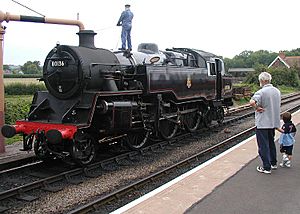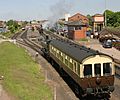Heritage railway facts for kids


A heritage railway is a special kind of railway that takes you back in time! It's also called a preserved railway in the United Kingdom or a tourist railroad in the United States and Canada. These railways are usually run by volunteers. Their main goal is to let people experience what train travel was like in the past. They are popular tourist attractions.
Contents
How Heritage Railways Started
Railways for Kids
Children's railways are places where kids and teenagers learn about how railways work. They are often real, working train lines that carry passengers. These special railways first appeared in the USSR during the Soviet era. Many were known as "Pioneer railways," named after a youth group.
The very first children's railway opened in Moscow in 1932. By the time the USSR broke up, there were 52 such railways. Even though some closed, many children's railways still run today in countries that were once part of the Soviet Union or Eastern Europe.
Many of these railways were built in city parks. Parks were good locations because they usually weren't redeveloped like industrial areas. Young volunteers and government support helped these railways exist. Children's railways that are still active often use their original tracks and trains. Some have even added older, historic trains from other lines.
- Some examples of children's railways with steam locomotives include:
- The Dresden Park Railway in Germany.
- The Gyermekvasút in Budapest, Hungary.
- The Park Railway Maltanka in Poznań, Poland.
- The Košice Children's Railway in Slovakia.
- A 7 1⁄4 in (184 mm) gauge steam railway at St Nicholas' School in Merstham, Surrey, England. Here, children help run the trains with adult volunteers.
Mountain Railways
Building train tracks up steep hills and through mountains is a big challenge. Engineers use special methods like Steep grade railway technologies and long tunnels. Using narrow gauge tracks helps because trains can make tighter turns. This also means tunnels and other structures don't need to be as big.
In high mountains, building is tough, and there aren't many towns needing transport. This means many mountain railways haven't been updated. The amazing engineering from the past and the beautiful mountain views make these railways popular tourist attractions today.
Mine Railways
Pit railways have been used in underground mines all over the world. Small trains carried ore, waste rock, and workers through narrow tunnels. Sometimes, trains were the only way to get around inside the mine. The size of the train often decided how big the tunnels had to be.
Many mine railways were left behind when mines closed or when new transport methods were used. However, some show mines now have old pit railways. Visitors can take a ride into the mine on these historic trains.
Underground Railways
The Metro 1 in Budapest, also known as the Millennium Underground Railway, is very old. It was built from 1894 to 1896. It's the oldest line in the Budapest Metro system and the second-oldest underground railway in the world!
The M1 was updated in the 1980s and 1990s. Today, Line 1 still uses eight of its original stations, keeping their historic look. In 2002, this line was named a UNESCO World Heritage Site. You can see many old items from the metro's early days at the Millennium Underground Museum in Deák Ferenc Square.
Images for kids
-
Train crossing a deck truss bridge on Serbia's Šargan Eight line
-
Puffing Billy Railway bridge
-
Peter Witt streetcar at the Halton County Radial Railway
-
Preserved railbus at the Porvoo railway station
-
The Darjeeling Himalayan Railway in West Bengal
-
Tweetsie Railroad locomotive
-
A SEPTA route 15 PCC trolley in Philadelphia around 2006
-
Three PCCs on the San Francisco Municipal Railway's F-line in 2003. Pictured are an example of one double-ended streetcar and two single-ended cars.
See also
 In Spanish: Tren histórico para niños
In Spanish: Tren histórico para niños


















